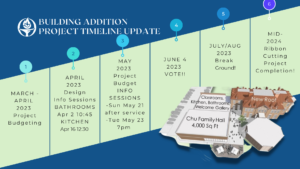 The date for voting on the New Addition budget has moved from April to June. You are probably wondering: Why?
The date for voting on the New Addition budget has moved from April to June. You are probably wondering: Why?
The answer in two words is: “value engineering”. Which leads to the next question: What is value engineering? The explanation may be easier by starting with another question: “Who are the players and what are their roles?”
Clients dream of buildings; they imagine their future in the new space. In 2019 our congregation voted to proceed with building a new addition with large gathering spaces, classrooms, a kitchen and plentiful restrooms.
Architects and engineers help translate those dreams into plans: Floor plans, interior and exterior views, plumbing plans, electrical plans, and mechanical plans for how to heat and cool the space.
Those plans are provided to the final player at the table, the contractors who bid the job. And, of course, it is the contractors who build buildings. Over dozens or even hundreds of projects, they develop a deep sense of what works ‘in the field’, and what doesn’t. What things truly cost, and how some costs can be avoided. It is this knowledge that sets the stage for value engineering.
In late March, the Gateways Task Force and our architect met separately with two contractors to review their bids and to elicit ideas for cost savings, i.e., to initiate the value engineering process. Both contractors brought ideas to the table. Over the next several days, our team refined the possibilities to identify ideas that, while using a different approach, still stayed as true as possible to the original vision, and which appeared to have the best potential for cost savings. Our architect then marked up the drawings to show the modified plans. Next, the contractors need time – about three weeks – to re-price the revised plans.
You might well wonder, what kinds of things are being considered, and why does it take so long?
Here is an example. The current plans call for two large HVAC units (heating and cooling units) for the large Chu Family Hall, with the units located on the lower roof. While this placement leaves the upper roof open for solar panels, it requires running ductwork from the units over the roof to deliver the heated/cooled air to the Hall. One contractor has suggested using four smaller HVAC units instead of two big ones, and locating them on the upper roof, right above the space to be heated/cooled. This would eliminate the need for much of the ductwork. Even though the cost of the units is fairly similar, eliminating a lot of ductwork saves real money, but since the upper roof was not designed to take the weight of HVAC units, some additional steel reinforcement would be required for this option.
As you can tell from this single example, which is one of several, value engineering can end up being a very complex equation, and we won’t really understand the possible cost savings until all the variables are priced out.
Once the value engineering information is available, Gateways will be in a position to put together a project budget to share with the Board and the Deeper Roots Capital Campaign Team. From those discussions, a recommended project budget and final funding plan will be developed and shared with the congregation in a series of information sessions. We now expect to be ready for a congregational vote on June 4, the date of our annual meeting. Stay tuned as things develop! And please make time to attend one of the budget information sessions scheduled for Sunday, May 21 after the Service and Tuesday, May 23 at 7pm (hybrid).
